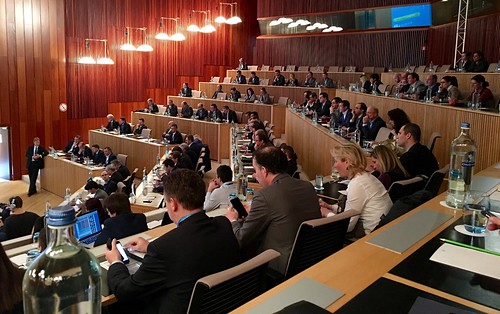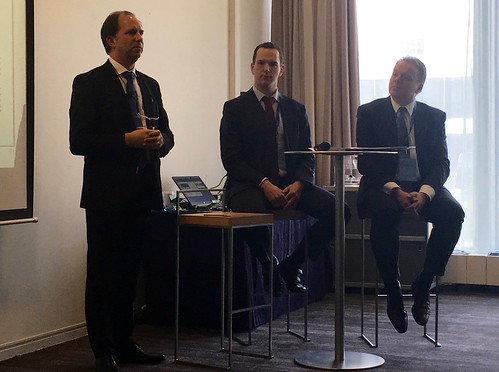Gottfried Leibbrandt, the CEO of SWIFT, gives the keynote speech at the European Payment Summit 2016.
I really like the annual European Payment Summit, which is why I’ve been going along to it for many years. It’s small scale, hype-free and attended by a lot of European payments practitioners that I respect. This year was the 15th summit and, just as last year, the topic of instant payments pervaded many of the sessions. Now, in the UK, we know all about the popularity of instant payments. We are all familiar with the steadily growing volumes for the U.K.’s Faster Payments Service (FPS), but I don’t think the experiences that we have had to date really illustrate where instant payments is going.
Having wandered in and out of a few of the sessions at the Summit and spent some time talking to people who are actual experts over coffee (and, I have to admit, a few glasses of Hoegaarden) I think that I detected a change in the focus of the thinking around instant payments. The emphasis had shifted from planning for instant payments as a new banking service to more practical discussions about instant payments in new products and services. I want to pick out two threads from these discussions to illustrate just how big the coming instant payments revolution will be: the use of data associated with payments and the linking of payments and data with social media.
Wim Raymaekers of SWIFT explaining GPII.
Data first. In the session discussing the SWIFT Global Payments Innovation Initiative (GPII, or “Business class SWIFT” as some people call it), one of the most interesting topics of discussion was the use of ISO 20022. This is the new financial industry message scheme, the international standard that defines the ISO platform for the development of financial message standards. Its business modelling approach allows users and developers to represent financial business processes and underlying transactions in a formal but syntax-independent notation. There are now 45 banks signed up for GPII, and they will all implement the standard properly. One particularly interesting aspect of ISO 20022 is that it allows data relating to a payment to go in the message alongs with the payment data. The collection of fields carrying this payment-related data are collectively referred to as Extended Remittance Information (ERI). The use of ERI fields to carry detailed payment-related data with instant payments will have a huge impact on the business use of instant payments of all kinds.
Right now, we think of ERI in terms of our existing business processes for invoicing, payments and all of the other processes that go around them, such as trade finance. When we move to an instant payments infrastructure, there will be an opportunity to deliver even more sophisticated services into this space. Remember that remittance advice could include data such as cryptographic keys to allow the recipient to access certain data, application code for execution (maybe even shared ledger applications to run on the block chain!) and other possibilities that I can’t even imagine.
The second strand to the revolution will be “chat and pay”, or the integration of instant payments into social media. If you look at the use of instant payment applications in the UK (PingIt and PayM) it is far less than the use of, for example, Venmo in the USA. And Venmo doesn’t deliver immediate settlement (it works through the debit card networks). In the last quarter of 2015, Venmo transferred $2.5 billion. In January 2016 alone it transferred $1 billion. So why is it so popular? It’s the integration with social media. Just over half the users are 18-24 and half the payments relate to food and drink sharing! On a US college campus, “I’ll Venmo you” has entered the lexicon. In the UK, “I’ll PingIt you” has not. Paym is growing steadily, but it it still only transferring about £12 million per month.
So now imagine, post-PSD2, the best of both worlds. The immediate availability of funds of PingIt and Paym with the integration of Venmo. It will be a wholly different payment experience. I’ll give you an obvious example. My wife and some of her friends are planning a weekend break in August. They do this through a Facebook chat group. But when it comes to settling up for hotels and air fares, everyone has to log out, e-mail everyone for their bank details and log in to home banking and set them up as payees, then make the payments. Then everyone else has to log in to their bank accounts to see if the money has arrived and that it is the right amount.
In 2018, however, it will all be different. Facebook will be Integrated with instant payments through APIs so that it can function as a transaction initiation service provider (TISP). When my wife gets a message to say that she owes her friend £100 for her air ticket, or £25 for her share of the dinner, or £10 for the tickets to a show, then she will put money into her return message just as she adds emoticons today. Under the hood, Facebook (which of course knows the bank account of the person you are sending a message to) will initiate an instant payment and within a second or so her friend will get a message to tell that the money has arrived. Remember, Facebook already do this is in the US through debit cards (like Venmo).

In a relatively short time we’ve moved from thinking of instant payments as a bank service to instant payments as a platform for new services and now to instant payments as a layer integrated into business services. With remittance data set to transform the business use of instant payments and social media integration set to transform the personal use of instant payments, we really are moving into a new payments world.


Comments
Post a Comment